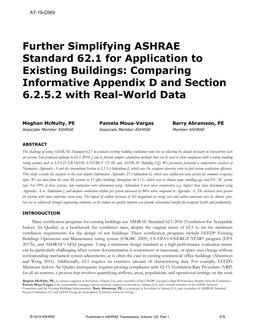Description
The challenge of using ASHRAE Standard 62.1 to evaluate existing building ventilation rates lies in collecting the details necessary to characterize eachair system. Two proposed addenda to 62.1-2016, f and b, provide simpler calculation methods that can be used to show compliance with existing buildingrating systems such as LEED EB O&M, ENERGY STAR and ASHRAE Building EQ. We previously presented a comparative analysis ofNormative Appendix A and the streamlined Section 6.2.5.3 (Addendum f), which uses the occupant diversity ratio to find system ventilation efficiency.This study extends the analysis to the even simpler Informative Appendix D (Addendum b), which uses airflow-per-area factors for common occupancytypes. We use data from the same 98 systems in 13 office buildings throughout the U.S., which vary in climate zone, building age, and HVAC systemtype. For 99% of these systems, new ventilation rates determined using Addendum b were more conservative (e.g. higher) than rates determined usingAppendix A or Addendum f, and median ventilation airflow per system increased by 84% when compared to Appendix A. The increases were greaterfor systems with more conference room area. The impact of airflow increases of this magnitude on energy cost and carbon emissions vary by climate zone,but can be addressed through engineering solutions, as the indoor air quality improve can provide substantial benefits for occupant health and productivity.
Citation: 2019 Winter Conference, Atlanta, GA, Conference Papers
Product Details
- Published:
- 2019
- Number of Pages:
- 8
- Units of Measure:
- Dual
- File Size:
- 1 file , 1.3 MB
- Product Code(s):
- D-AT-19-C069




